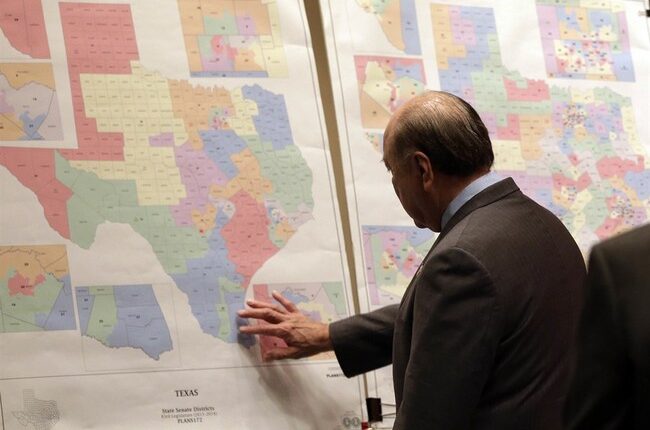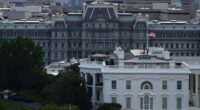
Yesterday we learned that a three judge panel had ruled 2-1 that Texas would not be allowed to use newly drawn maps in the midterm elections. U.S. District Judge Jeffrey V. Brown, who is a Trump appointee, joined U.S. District Judge David Guaderrama, an Obama appointee, to demand the state return to its previously drawn maps. The core of their ruling was that the goal of the redistricting was not partisan political advantage, but racial gerrymandering.
The state had argued that the entire redistricting process was based on a partisan goal, which the U.S. Supreme Court has previously said courts cannot intervene to prevent. But the plaintiffs pointed to a letter sent from the U.S. Department of Justice directing Texas to redraw its maps to eradicate four majority non-white districts, arguing that was the original sin that cast a racially discriminatory pall over the whole process…
“The Governor explicitly directed the Legislature to draw a new U.S. House map to resolve DOJ’s concerns. In other words, the Governor explicitly directed the Legislature to redistrict based on race,” Brown wrote on behalf of the judges.
Given that the decision was 2-1, it was clear there must be a dissent somewhere but yesterday I didn’t see anything about it. It turns out that was by design. Today, Circuit Court Judge Jerry E. Smith’s dissent is circulating and it opens by explaining that the other two judges decided not to wait on his dissent. They said they didn’t have time and then issued their ruling without even seeing his dissent.
In summary, Judge Brown has issued a 160-page opinion without giving me any reasonable opportunity to respond…
On Wednesday November 12, Judge Brown sent a message stating, “We currently anticipate issuing our injunction on Saturday, November 15. We will endeavor to get you a draft before we issue it. Sadly, we do not believe we can wait for a dissenting opinion before we rule—the fuse is simply too short in light of Purcell. We will, however, note on the opinion that you are dissenting. We are not trying to cut you out, we just don’t have the time. Ideally, of course, we’d have liked to have seen your dissent before we issue our opinion, but that will also be impossible.”…
Any pretense of judicial restraint, good faith, or trust by these two judges is gone. If these judges were so sure of their result, they would not have been so unfairly eager to issue the opinion sans my dissent, or they could have waited for the dissent in order to join issue with it. What indeed are they afraid of?…
The entry on the district court docket brings up only Judge Brown’s opinion; the reader has no access to this dissent without opening a separate, non-consecutive docket entry. So this majority has “won” in terms of diminishing the impact of the dissent and the public’s access to it.
There’s a lot more to this but the short version is that they not only didn’t interact with his dissent, they didn’t even wait to include it with their decision.
And that brings us to the dissent itself which goes on for almost 100 pages. Here’s how it begins.
The main winners from Judge Brown’s opinion are George Soros and Gavin Newsom. The obvious losers are the People of Texas and the Rule of Law.
I dissent.
It gets more biting as it goes on.
Judge Brown could have saved himself and the readers a lot of time and effort by merely stating the following:
I just don’t like what the Legislature did here. It was unnecessary, and it seems unfair to disadvantaged voters. I need to step in to make sure wiser heads prevail over the nakedly partisan and racially questionable actions of these zealous lawmakers. Just as I did to the lawmakers in Galveston County in Petteway, I’m using my considerable clout as a federal district judge to put a stop to bad policy judgments. After all, I get paid to do what I think is right.
Next up is the line from which I got my headline:
In 37 years as a federal judge, I’ve served on hundreds of three-judge panels. This is the most blatant exercise of judicial activism that I have ever witnessed.
Eventually, he gets to his main point. That there is no doubt these maps are about political gain.
Regardless of one’s political slant, it’s obvious what Texas is trying to do in 2025. The Republicans’ national margin in the House of Representatives is so slim that squeezing out a majority might even depend, day-to-day, on whether some seats are vacant because of deaths or resignations.
In 2021, the Texas Legislature, with both houses controlled by Republicans, devised a strategy of creating safe seats for both Republicans and Democrats, but with a decided majority of the state’s delegation still Republican. Whether (as a matter of political clout) that was the wisest strategy is disputed and indeed was fulsomely debated in 2021.
In mid-2025, the strategy changed: The new plan was to make more seats winnable for Republicans by moving some Democrats incumbents from their districts and rendering other districts unwinnable by Democrats. That sacrificed the wider margins in some of the old districts. The tradeoff is obvious.
There is some speculation that this new strategy will backfire on Republicans in 2026 because, if they do poorly in the mid-terms, the new Republican seats created in 2025 will be a Pyrrhic victory, because they will lose elections in the closer districts. That is purely a matter of political strategy that federal judges have no business touching.
The challenge faced by these plaintiffs and Judge Brown is to explain how it could be that the Republicans would sacrifice their stated goal of political gain for racial considerations. It makes no sense to advance the notion that the Republican Legislature would draw districts for the purpose of disadvantaging racial and ethnic minorities if, by doing so, they lessen the number of new Republican seats they might gain.
The plaintiffs’ theory is both perverse and bizarre. They actually contend that if the Republicans are sincere about gaining more seats, they could have drawn not five, but six, seven, or eight additional seats and that the reason they did not is that the real reason is racial animus. The absurdity of that notion speaks for itself. Yet it’s all that the plaintiffs and Judge Brown have to offer to defeat the State’s claim that the 2025 lines were drawn for the sake of politics and not race.
Judge Smith then walks through how Judge Brown sidesteps that obvious conclusion. I’m not going to include all of it here but his disdain for Judge Brown is very evident on every page. Here’s a sample of some of the best lines:
- If this were a law school exam, the opinion would deserve an “F.”
- Judge Brown is an unskilled magician. The audience knows what is coming next.
- How could that be? Because Judge Brown said so.
- Confused yet? You can thank Judge Brown for that.
- Judge Brown’s injunction is the epitome of judicial tinkering.
- …true to form, Judge Brown prefers living in fantasyland.
- Whether Judge Brown likes it, gravity exists.
Eventually, he returns to the core of the issue. Were the maps drawn for partisan gain or for racial reasons. On that point, he argues that the key witness in the case was the man who drew the new maps.
This panel decides both law and fact. The salient issue of fact is whether the Legislature drew the new lines on account of race. The answer is easy: It did not. And that question is not even close…
In that regard, everyone can agree that the star witness was Adam Kincaid. For months, there was controversy as to who drew “the map.” Without dispute, it turns out to be Kincaid. He is a paid, experienced, dedicated Republican operative, through and through. His lengthy testimony was the highlight of the preliminary-injunction trial.
Kincaid courageously spoke the truth, despite being the target of what authorities termed a “credible death threat” made shortly before he was scheduled to testify. As one of the finders of fact, I conclude that Kincaid was credible in every respect.
Knowing that Kincade is credible, Judge Brown makes every effort to ignore or circumvent Kincaid’s solid testimony. Judge Brown avoids the details of that testimony. Because he won’t tell you that, I do so now.
Adam Kincaid’s testimony is credible and irrefutable. Beginning in the Panhandle and moving clockwise, he went district-by-district and described his map-drawing process with painstaking detail (and without any notes for two days). His testimony is methodically detailed, and he is a solid witness, especially on the key question of intent and race…
In no uncertain terms, Kincaid stated “I don’t think it’s constitutional to draw maps based off of race.” 46:13-14. He unequivocally said “I do not” use race as a proxy for partisanship when drawing a map. 56:79. Instead, he reiterated that he used partisan data at the block level. 47:2052:19. He said, “I drew my map using politics from start to finish and provided that to the Legislature.” Tr. 10/7/25 PM 93:11-12. As if he could not be clearer, Kincaid repeated, “I drew a race-blind map using partisan results, and that’s how I created the map.”
The dissent then walks through changes made in every district and why they were made and how the drawing of each one was meant to ensure no Republican lost a seat. It was, in short, purely political.
He concludes his dissent with a bullet point list of claims made by Judge Brown that were either misleading or outright false. He concludes: “This order, replete with legal and factual error, and accompanied by naked procedural abuse, demands reversal.”
I’m not sure reversal is possible at this point but I guess we’ll see.
Editor’s Note: Do you enjoy Hot Air’s conservative reporting that takes on the radical left and woke media? Support our work so that we can continue to bring you the truth.
Join Hot Air VIP and use the promo code FIGHT to get 60% off your VIP membership!









